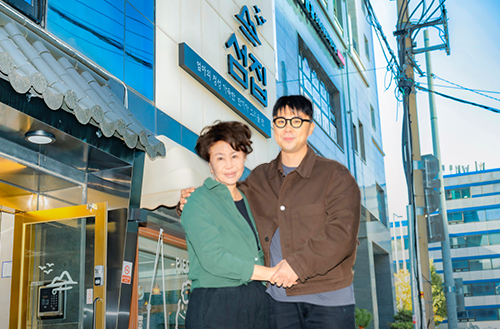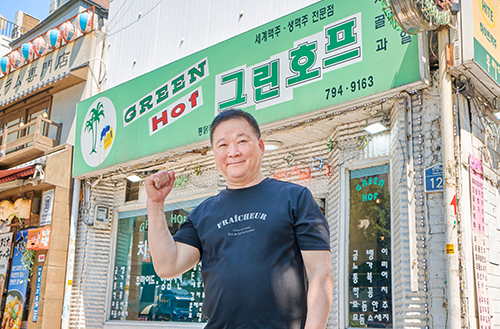
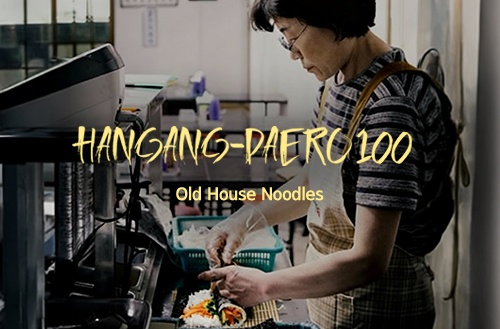

One hundred meters from Exit 1 of Samgakji Station. Walk down the narrow alley beside the 55-year-old Samgak Mansion, and you’ll spot a small triangular courtyard with a low building across from it, distinguished by its red awning. Next to it stands a weathered vertical sign with the endearing words “Old House Noodles & Kimbap.” The traces of time, steadfast in their place for so long, feel reassuring in themselves, and the unchanging flavors over 44 years have become soul food for countless people. We sat down with Jinsook Kim, who carries on Old House Noodles following in the footsteps of her mother, Hyeja Bae, who passed away two years ago, to share stories about the warm hearts of the people along Hangang-daero.
Years That Flew By in Warmth, Hardly Feeling the Hardship

So you’re running a second-generation noodle shop? Are you the daughter or daughter-in-law?
I’m the daughter. They say these days mothers don’t pass down their secrets to daughters-in-law! (laughs) Mom started the noodle shop right when I graduated high school. Business thrived, so after my kids entered elementary school, I’d help out whenever I could, and before I knew it, we were working together. My oldest is 36 now, so I’ve been at it for nearly 30 years.
Thirty years means you didn’t just inherit it—you built it together with your mother. What year did you first open?
It’s been 44 years, so we started in 1981. My mother worked consistently without a break for 42 years until she passed away two years ago from old age.
Do you remember when the noodle shop first started? What made you decide to do this?
There was already a noodle shop in this spot. That place also sold noodles and kimbap, and my mother took it over. After my father passed away from illness, she had four children to raise—me and my three younger brothers—so she had to start a business. She’d only been a homemaker, so she was worried about how to make a living. Someone she knew suggested that if she ran a noodle shop here, she’d at least be able to feed her kids. She didn’t even have the money to take over the business initially, so she started by borrowing from private lenders.
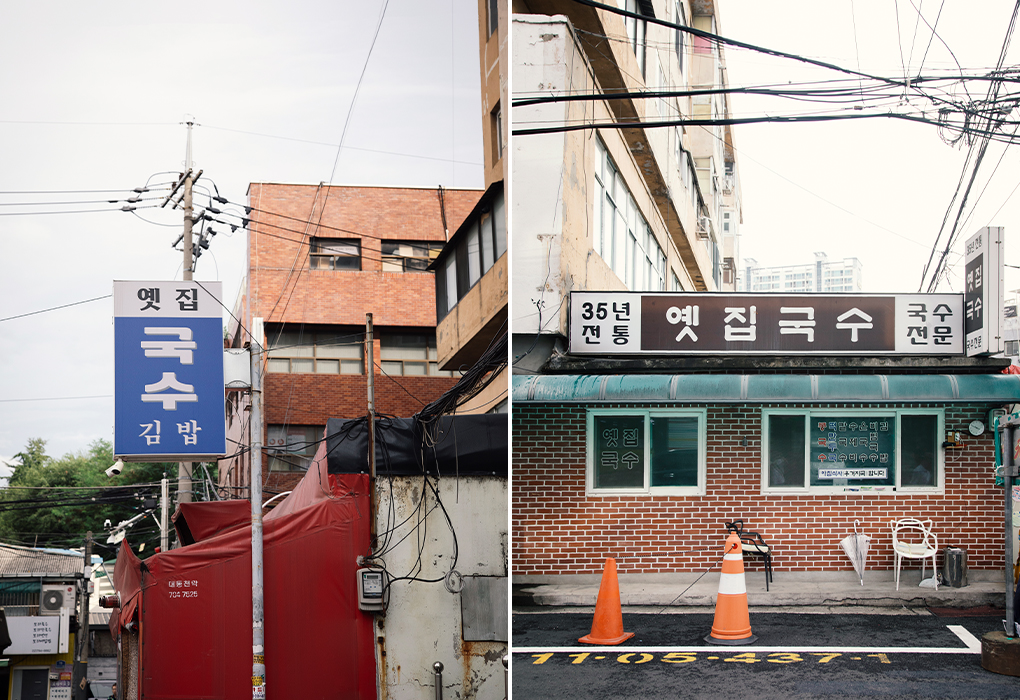
So your mother suddenly became the head of the household. Going from just managing a home to running a business—wasn’t that difficult for her?
She started because survival was urgent, but this turned out to be her calling. My mom never felt the hardship while doing this work. She was always happy. Just seeing customers enjoy their food made her feel good, and she found joy in taking care of people. She was naturally someone who loved giving to others. I don’t have any memories of our family eating alone together. From childhood, there was always someone besides family at our dinner table. If a neighbor mentioned they hadn’t eaten yet, she’d set a spoon on the table for them first thing. She was generous and loved making plenty to share. Even after I had children, I never ate a meal by myself. There was always someone else joining us for dinner.
She found work that perfectly matched her nature.
Yes, and that was such a blessing. Even when the work was demanding, she never felt it because she enjoyed it so much. She’d sell food for money, but she often said that someday she wanted to feed all the hungry people for free. Until three years ago, she’d sit at the kimbap station rolling kimbap while looking after all the customers, so she worked happily in the same spot for nearly 40 years. She just loved it when customers came in.
Your mother started this in her forties, which seems so young looking back now.
That’s right. As I’ve gotten older, it breaks my heart. My mom went through so much hardship here when she was so young. But then again, since she enjoyed the work, maybe it didn’t weigh on her as heavily. She’d give kimchi to regular customers, ask why they weren’t eating if they seemed to have no appetite, and worry if the portions were too small when they ate well. I can’t be like my mom. No matter how hard I try, I can’t do it the way she did.
With the Heart That People Should Eat Well and Live Well Today
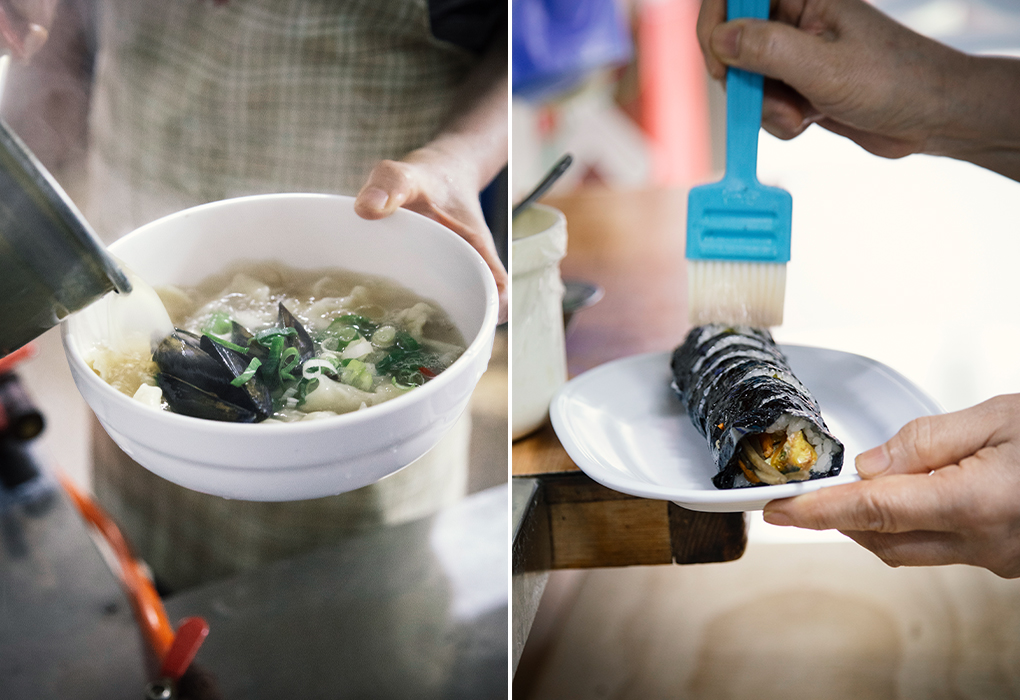
With 30 years of experience, you must have your own warmth. That’s why you still have regular customers, right?
Do you think so? Most of those regulars come because they’re thinking of my mom. That’s why it was so heartbreaking after she passed away. Just when I’d start to forget, people would come in and cry, and then I’d cry with them—my eyes never seemed to dry. I’m doing a bit better these days, but talking about Mom again today... I’m getting emotional again. I spent almost 24 hours a day with her. I can’t close the shop because I miss those years we spent together. And I still can’t help but think about the people who come here because they haven’t forgotten the taste of our noodles.
The rich, deep broth flavor you’ve developed is something you should definitely keep going. The warm noodles, spicy noodles, hand-pulled dough soup, bean noodles, and kimbap all feel as comforting as a home-cooked meal. Are you keeping the original menu?
Pretty much the same. When we first opened, we had three items: warm noodles, spicy noodles, and kimbap. As we established ourselves, we added menu items that complemented our anchovy broth base. We added rice cake soup, hand-pulled dough soup, and dried radish leaf soybean paste soup, plus bean noodles as a summer specialty. We make our own broth and even grind our own beans for the bean noodles. After Mom passed away, my younger brother came after work at night to carefully clean each anchovy and prepare the broth before going home. He also keeps everything spotlessly clean. Even when Mom was alive, our rule was to serve clean food in a clean environment.
I’m curious about who came up with the name ‘Old House.’ Did the family choose it together?
No, Mom chose it. She wanted people to think of her as their mother and come here feeling like they were going to their childhood home for a delicious meal made by Mom. She wanted them to think of it as their own home and eat their fill. Mom always told people to eat a lot and ask for more if they needed it. Even now, some regulars say it feels like Mom is there patting them on the back.

What a heartwarming scene. Just hearing about it, I can almost hear her voice. Was it like this from the very beginning?
Not at all. We expanded one section at a time every 10 years. At first, we just had what’s now the kitchen and this kimbap area. We started with four tables in that space. Do you see that gourd ladle next to the card reader? That’s 44 years old. It came in a bag of sugar back then, and I still clean it and use it today. It used to shine back then. We started with that one section, then every decade we took over the barber shop next door, then the metalworking shop next to that, then the tteokbokki place, expanding to our current size. You can see the pillars—we expanded one pillar at a time.
Business must have been incredibly good.
Not necessarily for that reason. We expanded to make customers more comfortable. When we started with those four small tables, the soldiers would pick up their chopsticks as soon as we brought out their noodle bowls and slurp them down quickly, saying the best way they could help our restaurant was to eat fast and leave, so people waiting wouldn’t go elsewhere. They said they needed to keep the turnover going. No matter how much Mom told them to sit comfortably and take their time, they’d say it was fine and quickly finish and get up. We felt sorry about that, so whenever we had the chance, we expanded. We were able to stay in business thanks to customers like that.
Writing History Together at Old House Noodles
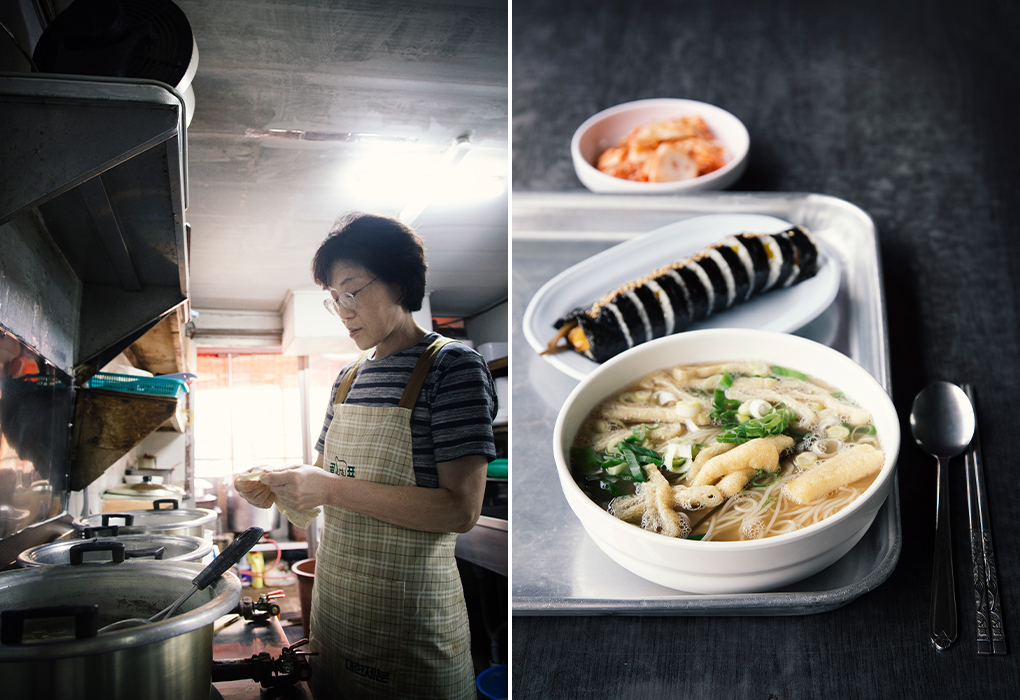
I’m curious about your primary customer base.
It’s similar now—mostly neighbors from around here and office workers. We had a lot of soldiers because the Army Headquarters and the Ministry of Defense are nearby. Some have become generals and still visit, and even those who’ve been transferred elsewhere stop by to share news of their marriages, kids, and how they’re doing. And we get a lot of office workers from Yongsan. When we see stylish, pretty customers come in, they’re usually Amorepacific employees. I use Sulwhasoo, hoping I’ll become as lovely as them someday! (laughs) It’s a bit of a walk for them, but we’re always grateful they make the effort. Oh, and these days we have a lot of foreign customers too.
Which countries do they mainly come from?
Many Japanese customers come seeking authentic Korean food. Our restaurant was featured in a Japanese book, which apparently made it a Seoul restaurant worth visiting. These days, there are many Japanese-style restaurants, and the alleys aren’t that different from Japan. But everything here is so old and unchanged that they find it refreshingly different and feel like they’re experiencing the real Korea. They try various types of kimbap and noodles. To give a good impression of our country, we strive to be even cleaner and provide better service.
Why do you think people come from far away, from nearby office workers to foreigners?
There’s nothing special about it. Our food is mild. It’s not dramatically flavorful or addictive, but after eating it, your stomach feels comfortable. We don’t use any artificial seasonings, so I think that’s why people keep coming back.
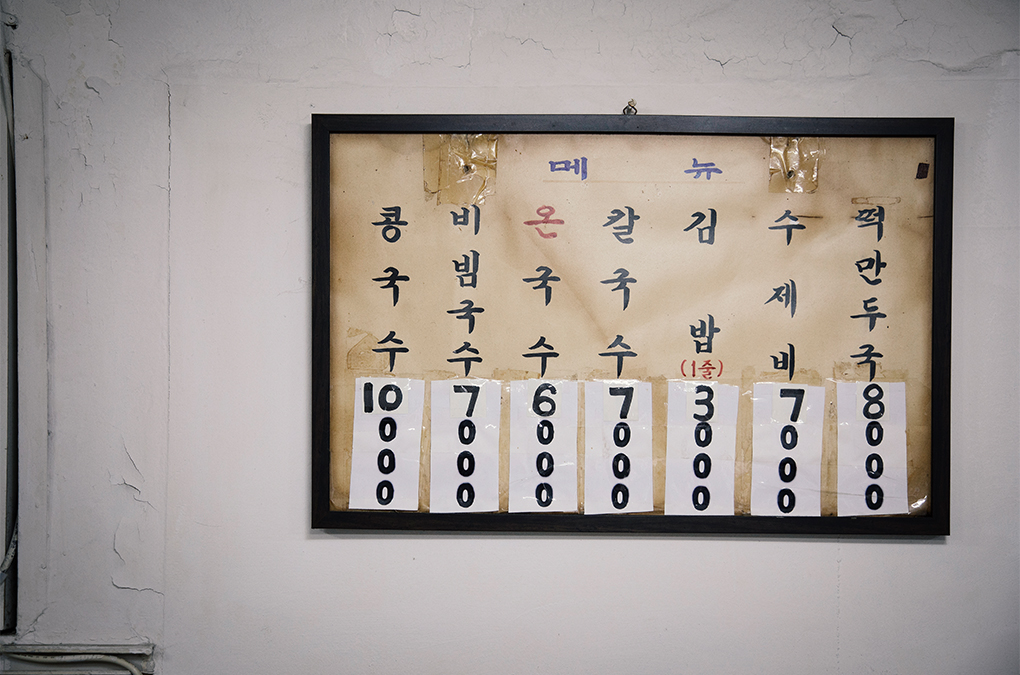
Over 40 years of operation—haven’t there been any difficult times?
We never had those kinds of problems. Everything was enjoyable. No matter how expensive cabbage got, we never used Chinese kimchi and always made it the way we always had. We make kimchi with 100 heads of cabbage every week. Since kimchi is the only side dish we serve, we make plenty. When cabbage prices skyrocketed, customers would go easy on the kimchi. When we’d ask if they wanted more, they’d say it was fine. People would bring us dried radish leaves from their hometowns for us to use, and vegetables like peppers and squash from their gardens. My mom used to joke that everything came through our door except a husband.
Even if you enjoyed it, opening at 6 AM every day couldn’t have been easy. When did you start opening at 6 AM?
We probably started around eight at first, but we’d turn on the lights early to prepare. Once the lights were on, customers would knock on the door. Mom said there must be people who left early and were hungry, so let’s hurry a bit and give them a warm breakfast. We have customers who only come at that time—people who start work very early, or those who live far away and leave early to avoid traffic. Those are our breakfast regulars. We serve breakfast and lunch, followed by dinner until 8 PM, before closing. If there’s leftover kimbap in the evening, we give out extra portions. Seeing people eat generously and with satisfaction brings us the greatest happiness.
Do you take vacations regularly?
We close every Saturday, and we have quiet moments in the afternoon each day. We take short summer and winter vacations and close for holidays. Back when Mom was alive, people would call asking if we weren’t open during holidays. When they said there was nowhere to eat and asked if we could open, Mom would invite them to our house to share holiday food. We lived nearby. We were just like neighbors and family with our customers. Those times were really heartwarming. These days we rest properly during holidays. (laughs)
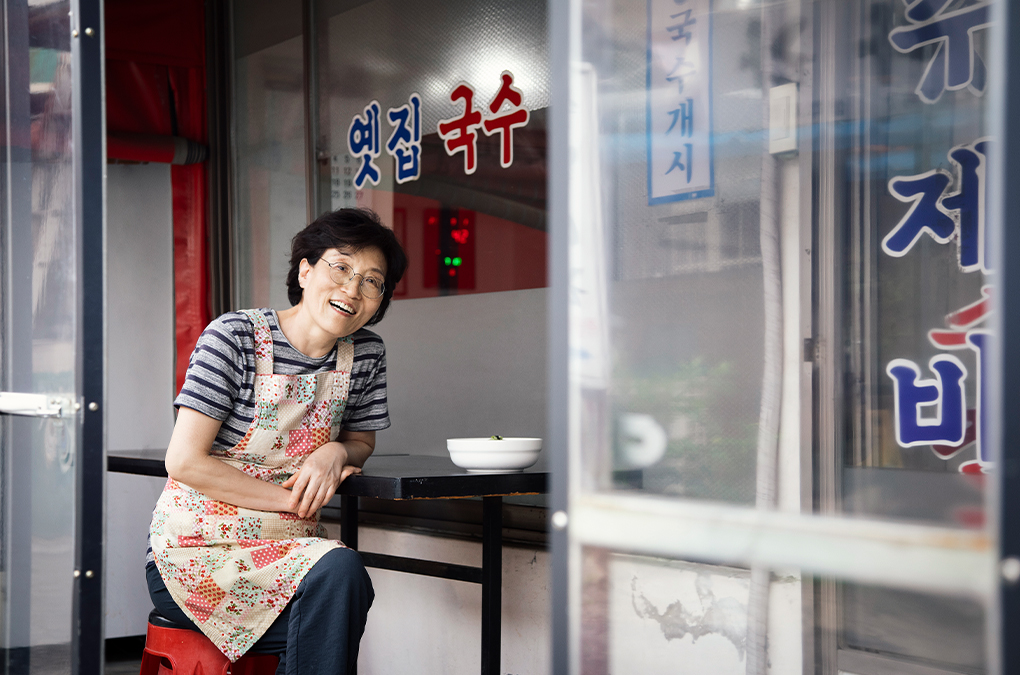
For your final thoughts, how would you like Old House Noodles to remain on Hangang-daero in the future?
Before the Amorepacific building was built, a small building stood there. There were little houses clustered together behind it. Then one day, this beautiful, impressive building went up, and I felt so pleased. I thought, finally, our Yongsan is shining. I hope Old House Noodles can be a source of that same kind of quiet satisfaction for the people of Hangang-daero. A while ago, a middle school student came with his mom. I remembered him because when he was in his mother’s womb, she craved our noodles throughout her pregnancy, and his father would get takeout in a thermos. It had to be hot when eaten, and noodles typically can’t be packaged because they get soggy, but when a pregnant woman wants something, how could we refuse? That child is already in middle school now. I hope it will be a taste he remembers even when he’s grown up, and just as we have for 44 years, we’ll continue to honestly and diligently preserve Mom’s flavors. Thank you to everyone who visits us, and please continue to support us.
Information
Old House Noodles
- Address: 26 Hangang-daero 62-gil, Yongsan-gu, Seoul (Located immediately after turning left into the alley from Exit 2 of Samgakji Station on Line 6)
- Hours: 06:00 - 20:00 (Closed Saturdays)
- Menu: Handmade chopped noodles 10,000 won, Spicy noodles 7,000 won, Kimbap 3,000 won

‘100 Hangang-daero’ brings you interviews with business owners around Amorepacific,
exploring the value and meaning of work through stories of passion, perseverance,
and overcoming adversity.
Content Production KAYA MEDIA
Planning Amorepacific Communications Team
-
Like
0 -
Recommend
0 -
Thumbs up
0 -
Supporting
0 -
Want follow-up article
0



